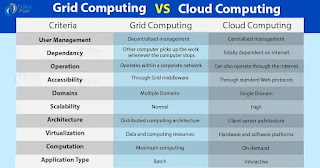Grid computing is a computing infrastructure that combines computer resources spread over different geographical locations to achieve a common goal. All unused resources on multiple computers are pooled together and made available for a single task. Organizations use grid computing to perform large tasks or solve complex problems that are difficult to do on a single computer.
For example, meteorologists use grid computing for weather modeling. Weather modeling is a computation-intensive problem that requires complex data management and analysis. Processing massive amounts of weather data on a single computer is slow and time consuming. That’s why meteorologists run the analysis over geographically dispersed grid computing infrastructure and combine the results.
Organizations use grid computing for several reasons.
Efficiency
With grid computing, you can break down an enormous, complex task into multiple subtasks. Multiple computers can work on the subtasks concurrently, making grid computing an efficient computational solution.
Cost
Grid computing works with existing hardware, which means you can reuse existing computers. You can save costs while accessing your excess computational resources. You can also cost-effectively access resources from the cloud.
Flexibility
Grid computing is not constrained to a specific building or location. You can set up a grid computing network that spans several regions. This allows researchers in different countries to work collaboratively with the same supercomputing power.
The following are some common applications of grid computing.
Financial services
Financial institutions use grid computing primarily to solve problems involving risk management. By harnessing the combined computing powers in the grid, they can shorten the duration of forecasting portfolio changes in volatile markets.
Gaming
The gaming industry uses grid computing to provide additional computational resources for game developers. The grid computing system splits large tasks, such as creating in-game designs, and allocates them to multiple machines. This results in a faster turnaround for the game developers.
Entertainment
Some movies have complex special effects that require a powerful computer to create. The special effects designers use grid computing to speed up the production timeline. They have grid-supported software that shares computational resources to render the special-effect graphics.
Engineering
Engineers use grid computing to perform simulations, create models, and analyze designs. They run specialized applications concurrently on multiple machines to process massive amounts of data. For example, engineers use grid computing to reduce the duration of a Monte Carlo simulation, a software process that uses past data to make future predictions.
Components of Grid Computing
In grid computing, a network of computers works together to perform the same task. The following are the components of a grid computing network.
Nodes
The computers or servers on a grid computing network are called nodes. Each node offers unused computing resources such as CPU, memory, and storage to the grid network. At the same time, you can also use the nodes to perform other unrelated tasks. There is no limit to the number of nodes in grid computing. There are three main types of nodes: control, provider, and user nodes.
Grid middleware
Grid middleware is a specialized software application that connects computing resources in grid operations with high-level applications. For example, it handles your request for additional processing power from the grid computing system.
It controls the user sharing of available resources to prevent overwhelming the grid computers. The grid middleware also provides security to prevent misuse of resources in grid computing.
Grid computing architecture
Grid architecture represents the internal structure of grid computers. The following layers are broadly present in a grid node:
The top layer consists of high-level applications, such as an application to perform predictive modeling.
The second layer, also known as middleware, manages and allocates resources requested by applications.
The third layer consists of available computer resources such as CPU, memory, and storage.
The bottom layer allows the computer to connect to a grid computing network.
Distributed computing
Distributed computing refers to a computing system where software components are shared among a group of networked computers. However, users who use the software will see a single coherent interface. For example, a web search engine is a distributed computing system. It allows you to search a specific website by sending the request to several servers.
Distributed computing compared to grid computing
Distributed computing aims to achieve a single goal at any one time. In contrast, grid computing does not act cohesively but allocates resources on its network for multiple related subtasks. A grid computing network might consist of several distributed computing systems.
Cluster computing
Cluster computing describes a network system comprised of homogeneous computers. Homogeneous computers have the same hardware and software. You can connect them to a high-speed local network to create a computer cluster that runs similar tasks. A centralized server controls and coordinates the machines.
Cluster computing compared to grid computing
Cluster computing has rigid and specific hardware, tasks, and control structure. Meanwhile, grid computing is flexible in terms of resource sharing. Computers on a grid network work independently and are not obliged to share resources. They have a resource manager that shares unused resources during runtime.






0 Comments